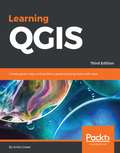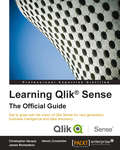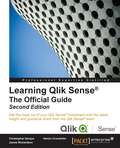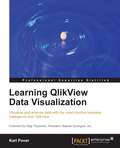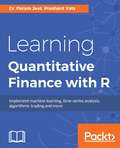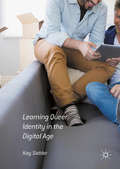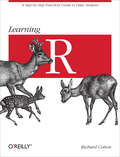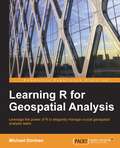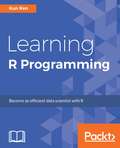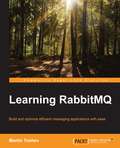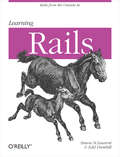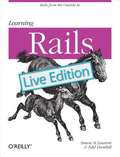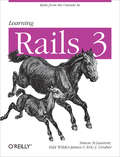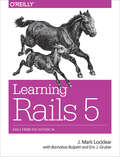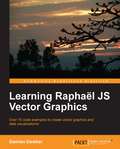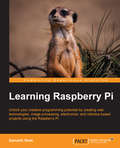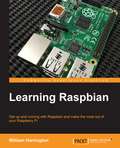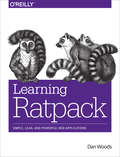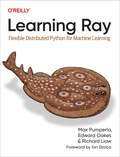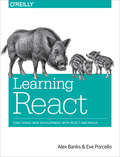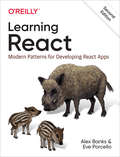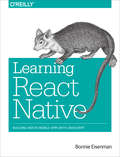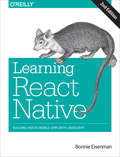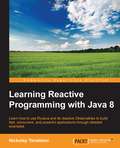- Table View
- List View
Learning QGIS - Third Edition
by Anita GraserThe latest guide to using QGIS 2.14 to create great maps and perform geoprocessing tasks with ease About This Book * Learn how to work with various data and create beautiful maps using this easy-to-follow guide. * Give a touch of professionalism to your maps both for functionality and look and feel with the help of this practical guide. * A progressive hands-on guide that builds on a geo-spatial data and adds more reactive maps by using geometry tools. Who This Book Is For This book is great for users, developers, and consultants who know the basic functions and processes of GIS and want to learn to use QGIS to analyze geospatial data and create rich mapping applications. If you want to take advantage of the wide range of functionalities that QGIS offers, then this is the book for you. What You Will Learn * Install QGIS and get familiar with the user interface * Load vector and raster data from files, databases, and web services * Create, visualize, and edit spatial data * Perform geoprocessing tasks and automate them * Create advanced cartographic outputs * Design great print maps * Expand QGIS using Python In Detail QGIS is a user-friendly open source geographic information system (GIS) that runs on Linux, Unix, Mac OS X, and Windows. The popularity of open source geographic information systems and QGIS in particular has been growing rapidly over the last few years. Learning QGIS Third Edition is a practical, hands-on guide updated for QGIS 2.14 that provides you with clear, step-by-step exercises to help you apply your GIS knowledge to QGIS. Through clear, practical exercises, this book will introduce you to working with QGIS quickly and painlessly. This book takes you from installing and configuring QGIS to handling spatial data to creating great maps. You will learn how to load and visualize existing spatial data and create data from scratch. You will get to know important plugins, perform common geoprocessing and spatial analysis tasks and automate them with Processing. We will cover how to achieve great cartographic output and print maps. Finally, you will learn how to extend QGIS using Python and even create your own plugin. Style and approach A step by step approach to explain concepts of Geospatial map with the help of real life examples
Learning Qlik® Sense: The Official Guide
by Christopher Ilacqua Henric CronstromLearning Qlik® Sense is for anyone seeking to understand and utilize the revolutionary new approach to business intelligence offered by Qlik Sense. Familiarity with the basics of business intelligence will be helpful when picking up this book, but not essential.
Learning Qlik Sense®: The Official Guide - Second Edition
by Christopher Ilacqua Henric Cronstrom James RichardsonGet the most out of your Qlik Sense investment with the latest insight and guidance direct from the Qlik Sense team About This Book * Updated with new coverage on Qlik Cloud, Qlik Sense Modeling, and Extending the Qlik Analytic Platform. * Get insider insight on Qlik Sense and its new approach to business intelligence * Explore practical demonstrations for utilizing Qlik Sense to discover data for sales, human resources, and more Who This Book Is For Learning Qlik Sense®: The Official Guide Second Edition is for anyone seeking to understand and utilize the revolutionary new approach to business intelligence offered by Qlik Sense. Familiarity with the basics of business intelligence will be helpful when picking up this book, but not essential. What You Will Learn * Understand the vision behind the creation of Qlik Sense, and the promise that data discovery offers to you and your organization * Get to grips with the life cycle of a Qlik Sense application * Load and manage your data for app creation * Visualize your data with Qlik Sense's engaging and informative graphing * Administer your Qlik Sense system and monitor its security * Build efficient and responsive Associative Models * Extend the Qlik Analytic Platform with the Dev Hub * Optimize Qlik Sense for sales, human resources, and demographic data discovery In Detail The intuitive and powerful Qlik Sense visual analytics software allows anyone to engage in data discovery, to explore your data, and find meaningful insights to empower your business. Qlik Sense lets you easily create personalized reports and visualizations and reveal essential connections to show new opportunities from every angle. Written by members of the Qlik Sense team, this book is the official guide from Qlik to understanding and using their powerful new product with fully updated coverage to the latest features of the most modern edition of Qlik Sense. Benefit from the vision behind the development of Qlik Sense and get to grips with how Qlik Sense can empower you as a data discovery consumer. Learn how to create your own applications for Qlik Sense to customize it to meet your personal needs for business intelligence, and how to oversee and administer the Qlik Sense data architecture. Finally, explore utilizing Qlik Sense to uncover essential data, with practical examples on finding and visualizing intelligence for sales figures, human resources information, travel expense tracking, and demographic data discovery. Style and approach This book is a practical guide to understand what Qlik Sense is and how to implement it. This is an example-rich, step-by-step book to implement and optimize Qlik Sense for sales, human resources, and demographic data discovery.
Learning Qlikview Data Visualization
by Karl PoverA practical and fast-paced guide that gives you all the information you need to start developing charts from your data.Learning QlikView Data Visualization is for anybody interested in performing powerful data analysis and crafting insightful data visualization, independent of any previous knowledge of QlikView. Experience with spreadsheet software will help you understand QlikView functions.
Learning Quantitative Finance with R
by Prashant Vats Dr Param JeetImplement machine learning, time-series analysis, algorithmic trading and more About This Book • Understand the basics of R and how they can be applied in various Quantitative Finance scenarios • Learn various algorithmic trading techniques and ways to optimize them using the tools available in R. • Contain different methods to manage risk and explore trading using Machine Learning. Who This Book Is For If you want to learn how to use R to build quantitative finance models with ease, this book is for you. Analysts who want to learn R to solve their quantitative finance problems will also find this book useful. Some understanding of the basic financial concepts will be useful, though prior knowledge of R is not required. What You Will Learn • Get to know the basics of R and how to use it in the field of Quantitative Finance • Understand data processing and model building using R • Explore different types of analytical techniques such as statistical analysis, time-series analysis, predictive modeling, and econometric analysis • Build and analyze quantitative finance models using real-world examples • How real-life examples should be used to develop strategies • Performance metrics to look into before deciding upon any model • Deep dive into the vast world of machine-learning based trading • Get to grips with algorithmic trading and different ways of optimizing it • Learn about controlling risk parameters of financial instruments In Detail The role of a quantitative analyst is very challenging, yet lucrative, so there is a lot of competition for the role in top-tier organizations and investment banks. This book is your go-to resource if you want to equip yourself with the skills required to tackle any real-world problem in quantitative finance using the popular R programming language. You'll start by getting an understanding of the basics of R and its relevance in the field of quantitative finance. Once you've built this foundation, we'll dive into the practicalities of building financial models in R. This will help you have a fair understanding of the topics as well as their implementation, as the authors have presented some use cases along with examples that are easy to understand and correlate. We'll also look at risk management and optimization techniques for algorithmic trading. Finally, the book will explain some advanced concepts, such as trading using machine learning, optimizations, exotic options, and hedging. By the end of this book, you will have a firm grasp of the techniques required to implement basic quantitative finance models in R. Style and approach This book introduces you to the essentials of quantitative finance with the help of easy-to-understand, practical examples and use cases in R. Each chapter presents a specific financial concept in detail, backed with relevant theory and the implementation of a real-life example.
Learning Queer Identity in the Digital Age
by Kay SieblerThis book explores, through specific analysis of media representations, personal interviews, and historical research, how the digital environment perpetuates harmful and limiting stereotypes of queerness. Siebler argues that heteronormativity has co-opted queer representations, largely in order to sell goods, surgeries, and lifestyles, reinforcing instead of disrupting the masculine and feminine heterosexual binaries through capitalist consumption. Learning Queer Identity in the Digital Age focuses on different identity populations (gay, lesbian, transgender) and examines the theories (queer, feminist, and media theories) in conjunction with contemporary representations of each identity group. In the twenty-first century, social media, dating sites, social activist sites, and videos/films, are primary educators of social identity. For gay, lesbian, bisexual, transgendered, and transsexual peoples, these digital interactions help shape queer identities and communities.
Learning R: A Step-by-Step Function Guide to Data Analysis
by Richard CottonLearn how to perform data analysis with the R language and software environment, even if you have little or no programming experience. With the tutorials in this hands-on guide, you'll learn how to use the essential R tools you need to know to analyze data, including data types and programming concepts. The second half of Learning R shows you real data analysis in action by covering everything from importing data to publishing your results. Each chapter in the book includes a quiz on what you've learned, and concludes with exercises, most of which involve writing R code. Write a simple R program, and discover what the language can do Use data types such as vectors, arrays, lists, data frames, and strings Execute code conditionally or repeatedly with branches and loops Apply R add-on packages, and package your own work for others Learn how to clean data you import from a variety of sources Understand data through visualization and summary statistics Use statistical models to pass quantitative judgments about data and make predictions Learn what to do when things go wrong while writing data analysis code
Learning R for Geospatial Analysis
by Michael DormanThis book is intended for anyone who wants to learn how to efficiently analyze geospatial data with R, including GIS analysts, researchers, educators, and students who work with spatial data and who are interested in expanding their capabilities through programming. The book assumes familiarity with the basic geographic information concepts (such as spatial coordinates), but no prior experience with R and/or programming is required. By focusing on R exclusively, you will not need to depend on any external software--a working installation of R is all that is necessary to begin.
Learning R Programming
by Kun RenBecome an efficient data scientist with R About This Book * Explore the R language from basic types and data structures to advanced topics * Learn how to tackle programming problems and explore both functional and object-oriented programming techniques * Learn how to address the core problems of programming in R and leverage the most popular packages for common tasks Who This Book Is For This is the perfect tutorial for anyone who is new to statistical programming and modeling. Anyone with basic programming and data processing skills can pick this book up to systematically learn the R programming language and crucial techniques. What You Will Learn * Explore the basic functions in R and familiarize yourself with common data structures * Work with data in R using basic functions of statistics, data mining, data visualization, root solving, and optimization * Get acquainted with R's evaluation model with environments and meta-programming techniques with symbol, call, formula, and expression * Get to grips with object-oriented programming in R: including the S3, S4, RC, and R6 systems * Access relational databases such as SQLite and non-relational databases such as MongoDB and Redis * Get to know high performance computing techniques such as parallel computing and Rcpp * Use web scraping techniques to extract information * Create RMarkdown, an interactive app with Shiny, DiagramR, interactive charts, ggvis, and more In Detail R is a high-level functional language and one of the must-know tools for data science and statistics. Powerful but complex, R can be challenging for beginners and those unfamiliar with its unique behaviors. Learning R Programming is the solution - an easy and practical way to learn R and develop a broad and consistent understanding of the language. Through hands-on examples you'll discover powerful R tools, and R best practices that will give you a deeper understanding of working with data. You'll get to grips with R's data structures and data processing techniques, as well as the most popular R packages to boost your productivity from the offset. Start with the basics of R, then dive deep into the programming techniques and paradigms to make your R code excel. Advance quickly to a deeper understanding of R's behavior as you learn common tasks including data analysis, databases, web scraping, high performance computing, and writing documents. By the end of the book, you'll be a confident R programmer adept at solving problems with the right techniques. Style and approach Developed to make learning easy and intuitive, this book comes packed with a wide variety of statistical and graphical techniques and a wealth of practical information for anyone looking to get started with this exciting and powerful language.
Learning RabbitMQ
by Martin ToshevBuild and optimize efficient messaging applications with ease About This Book * Learn to administer, configure, and manage RabbitMQ instances * Discover ways to secure and troubleshoot RabbitMQ instances * This book is fully up-to-date with all the latest changes to version 3.5 Who This Book Is For If you are a developer or system administrator with a basic knowledge of messaging who wants to learn RabbitMQ, or if you want to further enhance your knowledge in working with the message broker, then this book is ideal for you. To fully understand some examples in the book, a basic knowledge of the Java programming language is required. What You Will Learn * Apply messaging patterns using the message broker * Administer RabbitMQ using the command line, management Web console, or management REST services * Create a cluster of scalable, and highly-available, RabbitMQ instances * Use RabbitMQ with the Spring Framework, MuleESB, WSO2, and Oracle databases * Deploy RabbitMQ using Puppet, Vagrant, or Docker * Fine-tune the performance of RabbitMQ * Monitor RabbitMQ using Nagios, Munin, or Monit * Secure, troubleshoot, and extend RabbitMQ In Detail RabbitMQ is Open Source Message Queuing software based on the Advanced Message Queue Protocol Standard written in the Erlang Language. RabbitMQ is an ideal candidate for large-scale projects ranging from e-commerce and finance to Big Data and social networking because of its ease of use and high performance. Managing RabbitMQ in such a dynamic environment can be a challenging task that requires a good understanding not only of how to work properly with the message broker but also of its best practices and pitfalls. Learning RabbitMQ starts with a concise description of messaging solutions and patterns, then moves on to concrete practical scenarios for publishing and subscribing to the broker along with basic administration. This knowledge is further expanded by exploring how to establish clustering and high availability at the level of the message broker and how to integrate RabbitMQ with a number of technologies such as Spring, and enterprise service bus solutions such as MuleESB and WSO2. We will look at advanced topics such as performance tuning, secure messaging, and the internals of RabbitMQ. Finally we will work through case-studies so that we can see RabbitMQ in action and, if something goes wrong, we'll learn to resolve it in the Troubleshooting section. Style and approach Each chapter of the book is an easy-to-follow guide that expands and builds on the knowledge already gained in previous chapters. Throughout the course of the book, a sample system called the CSN (Corporate Social Network) is used to illustrate the core principles described. At the end of each chapter, there is a Q&A session that covers practical questions that may arise in practice when working with RabbitMQ.
Learning Rails
by Simon St. Laurent Edd DumbillWhile most books written about Rails cater to programmers looking for information on data structures, Learning Rails targets web developers whose programming experience is tied directly to the Web. Rather than begin with the inner layers of a Rails web application--the models and controllers--this unique book approaches Rails development from the outer layer: the application interface. You'll learn how to create something visible with Rails before reaching the more difficult database models and controller code. With Learning Rails, you can start from the foundations of web design you already know, and then move more deeply into Ruby, objects, and database structures. This book will help you: Present web content by building an application with a basic view and a simple controller, while learning Ruby along the way Build forms and process their results, progressing from the simple to the more complex Connect forms to models by setting up a database, and use Rails' ActiveRecord to create code that maps to database structures Use Rails scaffolding to build applications from a view-centric perspective Add common web application elements such as sessions, cookies, and authentication Build applications that combine data from multiple tables Create simple but dynamic interfaces with Rails and Ajax Once you complete Learning Rails, you'll be comfortable working with the Rails web framework, and you'll be well on your way to becoming a Rails guru.
Learning Rails: Live Edition
by Simon St. Laurent Edd DumbillReady to learn Rails? Get up to speed using the framework's latest release. In this Live Edition, Learning Rails has been updated to cover Rails 2.3.5, making it an ideal guide for Rails beginners. Unlike most Rails books, Learning Rails is for web developers, and not for programmers. Rather than begin with the inner layers of a Rails web application -- the models and controllers -- this book approaches Rails development from the outer layer: the view side of an application. You'll start from the foundations of the Web you already know, and learn how to create something visible with Rails before reaching the more difficult database models and controller code. Each chapter includes exercises and review questions so you can test your understanding as you go. Present content by building an application with a basic view and a simple controller, while learning Ruby along the way Build forms and process their results, progressing from simple to more complex Connect forms to models by setting up a database, and use Rails' Active Record to create code that maps to database structures Use Rails scaffolding to build applications from a view-centric perspective Add common web application elements such as sessions, cookies, and authentication Build applications that combine data from multiple tables Create simple but dynamic interfaces with Rails and Ajax O'Reilly Live Edition books give you access to updates to topics in between editions of a book. A Live Edition is an electronic and print-on-demand version of the book that is updated when there is a significant change to the software or technology the book covers, keeping you on top of .X releases or major fixes.
Learning Rails 3: Rails from the Outside In (Oreilly And Associate Ser.)
by Edd Dumbill Simon St. Laurent Eric J Gruber<p>If you’re a web developer or designer ready to learn Rails, this unique book is the ideal way to start. Rather than throw you into the middle of the framework’s Model-View-Controller architecture, <i>Learning Rails 3</i> works from the outside in. You’ll begin with the foundations of the Web you already know, and learn how to create something visible with Rails’ view layer. <i>Then</i> you’ll tackle the more difficult inner layers: the database models and controller code. All you need to get started is HTML experience.</p>
Learning Rails 5: Rails from the Outside In
by Gruber LocklearIf you're a web developer or designer ready to learn Ruby on Rails, this unique book is the ideal way to start.Rather than throw you into the middle of the framework's Model-View-Controller architecture, Learning Rails 5 works from the outside in. You'll begin with the foundations of the Web you already know, and learn how to create something visible with Rails' view layer. Then you'll tackle the more difficult inner layers: the database models and controller code.All you need to get started is HTML experience. Each chapter includes exercises and review questions to test your understanding as you go.
Learning Raphaël JS Vector Graphics
by Damian DawberA step-by-step guide to understanding the principles underlying vector drawing, using illustrations and code demos along with interactive maps to fully exploit the JavaScript library to create a data visualization widget.Learning Raphaël JS Vector Graphics has been written for anyone with an interest in frontend browser technologies with little or no knowledge of vector graphics drawing. Designers, integrators, frontend developers, and data visualization developers will get something out of reading this book. The book assumes knowledge of HTML and CSS and a working familiarity with JavaScript.
Learning Raspberry Pi
by Samarth ShahIf you have a passion for technology and want to explore the world of Raspberry Pi, then this book provides you with all the tools and information you are looking for. Although being familiar with basic programming concepts is useful, you can still learn a lot from this book as a wide variety of topics are covered.
Learning Raspbian
by William HarringtonThis book is intended for developers who have worked with the Raspberry Pi and who want to learn how to make the most of the Raspbian operating system and their Raspberry Pi. Whether you are a beginner to the Raspberry Pi or a seasoned expert, this book will make you familiar with the Raspbian operating system and teach you how to get your Raspberry Pi up and running.
Learning Ratpack: Simple, Lean, and Powerful Web Applications
by Dan WoodsBuild robust, highly scalable reactive web applications with Ratpack, the lightweight JVM framework. With this practical guide, you'll discover how asynchronous applications differ from more traditional thread-per-request systems--and how you can reap the benefits of complex non-blocking through an API that makes the effort easy to understand and adopt.Author Dan Woods--a member of the Ratpack core team--provides a progressively in-depth tour of Ratpack and its capabilities, from basic concepts to tools and strategies to help you construct fast, test-driven applications in a semantic and expressive way. Ideal for Java web developers familiar with Grails or Spring, this book is applicable to all versions of Ratpack 1.x.Configure your applications and servers to accommodate the cloudUse Ratpack testing structures on both new and legacy applicationsAdd advanced capabilities, such as component binding, with modulesExplore Ratpack's static content generation and serving mechanismsProvide a guaranteed execution order to asynchronous processingModel data and the data access layer to build high-performance, data-driven applicationsWork with reactive and functional programming strategiesUse distribution techniques that support continuous delivery and other deployment tactics
Learning Ray
by Max Pumperla Edward Oakes Richard LiawGet started with Ray, the open source distributed computing framework that simplifies the process of scaling compute-intensive Python workloads. With this practical book, Python programmers, data engineers, and data scientists will learn how to leverage Ray locally and spin up compute clusters. You'll be able to use Ray to structure and run machine learning programs at scale.Authors Max Pumperla, Edward Oakes, and Richard Liaw show you how to build machine learning applications with Ray. You'll understand how Ray fits into the current landscape of machine learning tools and discover how Ray continues to integrate ever more tightly with these tools. Distributed computation is hard, but by using Ray you'll find it easy to get started.Learn how to build your first distributed applications with Ray CoreConduct hyperparameter optimization with Ray TuneUse the Ray RLlib library for reinforcement learningManage distributed training with the Ray Train libraryUse Ray to perform data processing with Ray DatasetsLearn how work with Ray Clusters and serve models with Ray ServeBuild end-to-end machine learning applications with Ray AIR
Learning React: Functional Web Development with React and Redux
by Alex Banks Eve PorcelloIf you want to learn how to build efficient user interfaces with React, this is your book. Authors Alex Banks and Eve Porcello show you how to create UIs with this small JavaScript library that can deftly display data changes on large-scale, data-driven websites without page reloads. Along the way, you’ll learn how to work with functional programming and the latest ECMAScript features.Developed by Facebook, and used by companies including Netflix, Walmart, and The New York Times for large parts of their web interfaces, React is quickly growing in use. By learning how to build React components with this hands-on guide, you’ll fully understand how useful React can be in your organization.Learn key functional programming concepts with JavaScriptPeek under the hood to understand how React runs in the browserCreate application presentation layers by mounting and composing React componentsUse component trees to manage data and reduce the time you spend debugging applicationsExplore React’s component lifecycle and use it to load data and improve UI performanceUse a routing solution for browser history, bookmarks, and other features of single-page applicationsLearn how to structure React applications with servers in mind
Learning React: Modern Patterns for Developing React Apps
by Alex Banks Eve PorcelloIf you want to learn how to build efficient React applications, this is your book. Ideal for web developers and software engineers who understand how JavaScript, CSS, and HTML work in the browser, this updated edition provides best practices and patterns for writing modern React code. No prior knowledge of React or functional JavaScript is necessary.With their learning road map, authors Alex Banks and Eve Porcello show you how to create UIs that can deftly display changes without page reloads on large-scale, data-driven websites. You’ll also discover how to work with functional programming and the latest ECMAScript features. Once you learn how to build React components with this hands-on guide, you’ll understand just how useful React can be in your organization.Understand key functional programming concepts with JavaScriptLook under the hood to learn how React runs in the browserCreate application presentation layers with React componentsManage data and reduce the time you spend debugging applicationsIncorporate React Hooks to manage state and fetch dataUse a routing solution for single-page application featuresLearn how to structure React applications with servers in mind
Learning React Native
by Bonnie EisenmanGet a practical introduction to React Native, the JavaScript framework for writing and deploying fully featured mobile apps that look and feel native. With this hands-on guide, you'll learn how to build applications that target iOS, Android, and other mobile platforms instead of browsers. You'll also discover how to access platform features such as the camera, user location, and local storage.With code examples and step-by-step instructions, author Bonnie Eisenman shows web developers and frontend engineers how to build and style interfaces, use mobile components, and debug and deploy apps. Along the way, you'll build several increasingly sophisticated sample apps with React Native before putting everything together at the end.Learn how React Native provides an interface to native UI componentsExamine how the framework uses native components analogous to HTML elementsCreate and style your own React Native components and applicationsInstall modules for APIs and features not supported by the frameworkGet tools for debugging your code, and for handling issues outside of JavaScriptPut it all together with the Zebreto effective-memorization flashcard appDeploy apps to the iOS App Store and Google's Play Store
Learning React Native: Building Native Mobile Apps with JavaScript
by Bonnie EisenmanGet a practical introduction to React Native, the JavaScript framework for writing and deploying fully featured mobile apps that look and feel native. With this hands-on guide, you’ll learn how to build applications that target iOS, Android, and other mobile platforms instead of browsers. You’ll also discover how to access platform features such as the camera, user location, and local storage.With code examples and step-by-step instructions, author Bonnie Eisenman shows web developers and frontend engineers how to build and style interfaces, use mobile components, and debug and deploy apps. Along the way, you’ll build several increasingly sophisticated sample apps with React Native before putting everything together at the end.Learn how React Native provides an interface to native UI componentsExamine how the framework uses native components analogous to HTML elementsCreate and style your own React Native components and applicationsInstall modules for APIs and features not supported by the frameworkGet tools for debugging your code, and for handling issues outside of JavaScriptPut it all together with the Zebreto effective-memorization flashcard appDeploy apps to the iOS App Store and Google’s Play Store
Learning React Native: Building Native Mobile Apps with JavaScript
by Bonnie EisenmanGet a practical introduction to React Native, the JavaScript framework for writing and deploying fully featured mobile apps that render natively. The second edition of this hands-on guide shows you how to build applications that target iOS, Android, and other mobile platforms instead of browsers—apps that can access platform features such as the camera, user location, and local storage.Through code examples and step-by-step instructions, web developers and frontend engineers familiar with React will learn how to build and style interfaces, use mobile components, and debug and deploy apps. You’ll learn how to extend React Native using third-party libraries or your own Java and Objective-C libraries.Understand how React Native works under the hood with native UI componentsExamine how React Native’s mobile-based components compare to basic HTML elementsCreate and style your own React Native components and applicationsTake advantage of platform-specific APIs, as well as modules from the framework’s communityIncorporate platform-specific components into cross-platform appsLearn common pitfalls of React Native development, and tools for dealing with themCombine a large application’s many screens into a cohesive UXHandle state management in a large app with the Redux library
Learning Reactive Programming with Java 8
by Nickolay TsvetinovIf you are a Java developer that knows how to write software and would like to learn how to apply your existing skills to reactive programming, this book is for you.
